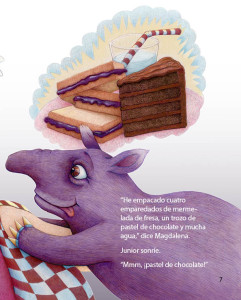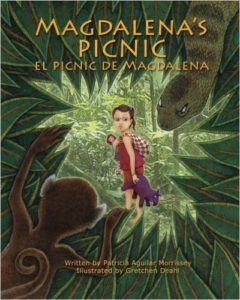 One of the main characters of Magdalena’s Picnic is Junior, a purple tapir. I read the book to my little neighbor and he asked if tapirs were really purple. They are not, of course. Junior has very distinct markings around his prehensile snout. He has whitish markings around his lips. This makes him a Peruvian mountain tapir. Junior is a purple mountain tapir! He is a little bit of a scaredy cat, a little grumpy and LOVES chocolate cake. I think he will endear himself to the readers. Uno de los personajes principales de El picnic de Magdalena es Junior, un tapir morado. Ayer le leí el libro a mi vecinito y me preguntó si los tapires son realmente morados. Por supuesto que no. Junior tiene unas marcas blancas características de su especie alrededor de la boca. Como si fueran labios. Esto quiere decir que es un tapir peruano de montaña. ¡Junior es un tapir de montaña morado! Es un poquito miedoso, un poquito gruñón y le encanta el pastel de chocolate. Creo que se va a convertir en el favorito de los lectores. Click here for more Tapir info
One of the main characters of Magdalena’s Picnic is Junior, a purple tapir. I read the book to my little neighbor and he asked if tapirs were really purple. They are not, of course. Junior has very distinct markings around his prehensile snout. He has whitish markings around his lips. This makes him a Peruvian mountain tapir. Junior is a purple mountain tapir! He is a little bit of a scaredy cat, a little grumpy and LOVES chocolate cake. I think he will endear himself to the readers. Uno de los personajes principales de El picnic de Magdalena es Junior, un tapir morado. Ayer le leí el libro a mi vecinito y me preguntó si los tapires son realmente morados. Por supuesto que no. Junior tiene unas marcas blancas características de su especie alrededor de la boca. Como si fueran labios. Esto quiere decir que es un tapir peruano de montaña. ¡Junior es un tapir de montaña morado! Es un poquito miedoso, un poquito gruñón y le encanta el pastel de chocolate. Creo que se va a convertir en el favorito de los lectores. Click here for more Tapir info
Magdalena’s Picnic or El picnic de Magdalena
Last year, I wrote a children’s book, bilingual – of course – published by Wednesday Night Press of Portland, Oregon and is available at bookstores everywhere. The name of the book is Magdalena’s Picnic / El picnic de Magdalena. In this story, a young girl and two of her favorite friends – a doll named Brigitte and Junior, the purple tapir- have an adventure in the Amazon jungle, but, is she really in the Amazon? There is information about the Amazon, tapirs, anacondas and more…
The book is on the summer reading list of the SCBWI (Society of Children’s Book Writers and Illustrators) where you can also find other wonderful picture books. I hope all bilingual families and those learning Spanish or English enjoy it!
El año pasado escribí un libro – bilingüe – por supuesto, publicado por Wednesday Night Press de Portland, Oregón. El título es: Magdalena’s Picnic / El picnic de Magdalena. En este cuento, una niña y dos de sus amigos preferidos – una muñeca que se llama Brigitte y Junior, el tapir morado- tienen una aventura en la selva amazónica, pero, ¿están realmente en la Amazonía? Hay información sobre el Amazonas, tapires, anacondas y más…
Este libro está en la lista de verano de SCBWI (Society of Children’s Book Writers and Illustrators) donde también pueden encontrar otrso libros maravillosos para niños. ¡Espero que todas la familias bilingües y todos los que estén aprendiendo castellano o inglés lo disfruten!
The flashlight or the torch?
Standing in line at Powell’s Books I heard the following:
“Is this the British or the American version?”
“The American,” said the Powell’s Lady and handed back the Harry Potter book. When it was my turn to pay for Sasquatch by Roland Smith (great grade book for any kid around 7 or 8) I asked about the difference between the American and British versions of the Harry Potter books and was told that the American versions have substituted the British lexicon with words used in the US. So, here in America, Harry and friends run around wearing their sweaters while in the original version they wear jumpers.
Why do we underestimate our readers? Are we wasting an opportunity to broaden language and cultural horizons in American children?
¿Judías verdes, ejotes, vainitas o chauchas?
Depende del país de origen. Dada la variedad de culturas que forman los países de habla hispana tenemos, especialmente en el área de alimentos, una variedad enorme de vocablos que representan exactamente lo mismo. He ahí el dilema. Al escribir libros bilingues, ¿qué palabra usar? ¿Debemos ser fieles al lugar donde ocurre la historia? o como autora, ¿debo usar mis regionalismos? Mmmm.
Acabo de escribir un cuento acerca de una chompa…
bilingual or embedded?
For the past year I have been writing bilingual stories – es decir cuentos en español y en inglés … and I have come to a fork in the road – literalmente, un tenedor en la carretera o, mejor dicho, una disyuntiva: bilingual or embedded?
So, while bilingual enables me to write either in English or Spanish to my heart’s content – con el corazón alegre o, mejor dicho, tanto como quiera, when writing embedded stories I have to think about syntax, precise word choice and if the reader, non Spanish speaker, will understand the word(s).
So, I can write,using the embedded format:
Her favorite sweater was made of wool and kept her warm through the cold nights.
as
Her favorite sweater was made of lana and kept her warm during the cold nights.
So, as a non Spanish speaker can you figure it out? Could lana mean silk? leaves? or logically, wool?
On the other hand, most readers don’t want to work as they read. They will be expecting the full translation, at the bottom of the page: Su chompa favorita era de lana y la mantenía abrigada durante las noches frías.
Next time you are browsing through children’s books, go to the bilingual section and look, you will find both.
By the way, the use of chompa vs suéter is another story…
- « Previous Page
- 1
- …
- 8
- 9
- 10
